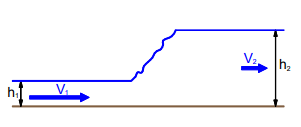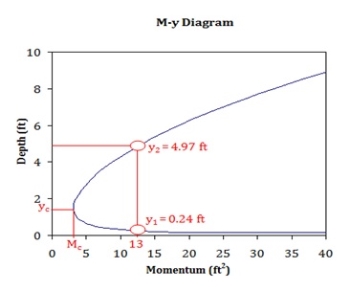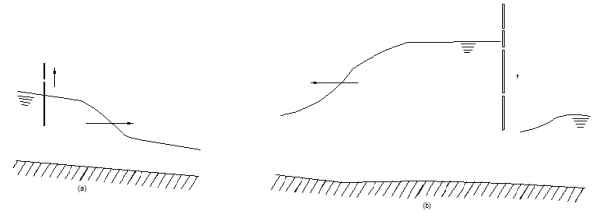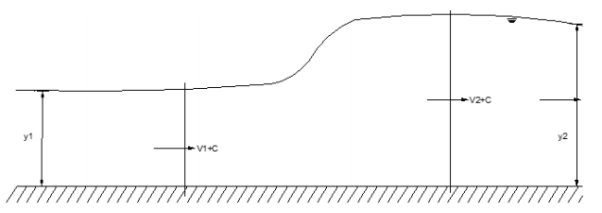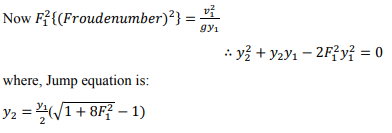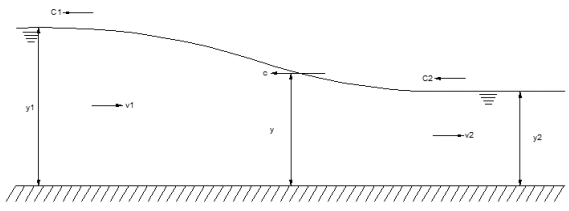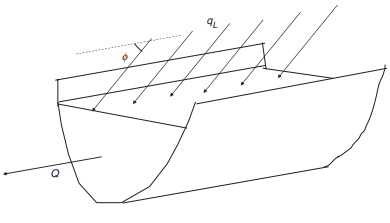|
Consider a control volume encompassing the jump. By the momentum principle: net pressure force = rate of change of momentum
Since streamlines are parallel there, pressures at inflow and outflow stations 1 and 2 are hydrostatic and the average pressure is the pressure at the centroid; i.e. 𝑝̅= ρ𝑔𝑑̅, where 𝑑̅is the depth of the centroid below the surface. Using this, and substituting for velocity,
|
|
𝑑̅= 1 /2 ℎ, 𝐴 = ℎ𝑏, 𝑄 = 𝑞𝑏 and the momentum principle reduces to
Dividing by ρ𝑏:
Divide through by 𝑔(ℎ1 − ℎ2) (non-zero by assumption) and then multiply by ℎ1ℎ2:
Since we are looking for the depth ratio ℎ2⁄ℎ1, divide through by ℎ1 3 :
Since 𝑞 = 𝑉ℎ, the RHS is 𝑉12 /𝑔ℎ1 or Fr12. Hence,
This is a quadratic equation for the depth ratio ℎ2⁄ℎ1 and its positive root gives the downstream depth in terms of upstream quantities:
|
|
Beginning with an equal momentum flux M and discharge q upstream and downstream of the hydraulic jump:
Rearranging terms gives:
Multiply to get a common denominator on the left-hand side and factor the right-hand side:
The (y2−y1) term cancels out:
Divide by y12
Thereafter multiply by y2 and expand the right-hand side:
Substitute x for the constant y2/y1:
Solving the quadratic equation and multiplying it by √4/2 gives:
Substitute the constant y2/y1 back in for x to get the conjugate depth equation
|
|
|
|
|
|
Q5) Describe a surge in an open channel.
A5) The sudden changes of flow in the open channel result in the increase or decrease of flow depth are called the "surge" in an open channel. This could take place when there is a breaching of dams due to earthquakes or regulating the hydropower sluice gates. Hence results in positive and negative surges in the downstream river channel or the downstream tail channel of hydropower projects. This phenomenon also governs when there would be flood (unsteady flow) during the monsoon period in natural river channels and the hydrograph significantly varies with rising and falling as the rainfall takes its peak period. The flood wave generates during the positive or negative surges is called the celerity (wave velocity) of the flood in an unsteady flow situation.
This positive or negative surge sometimes travels downstream or upstream depending on the situation. The increase in flow depth would become the crest of the surges and the decrease in the flow depth would become the trough of the surges.
|
|
|
Q6) Derive upstream and downstream positive surge formula.
A6) The upstream positive surge wave Consider the propagation of a positive wave upstream in a frictionless channel resulting from gate closure
|
|
The continuity equation is: A1(V1+c)= A2(V2+c) The momentum equation is:
Where y1ˉ and y2ˉ are respective depths of the centers of the area. From simplification, we get
In the special case of the rectangular channel,
From the above equation, it can be written as
then; The hydraulic jump in a stationary surge. Putting c=0, in the above equation
In the case of a low wave where y2 approaches y1 then the equation becomes Then c=√gy=v1 And in still water (v1=0) c=√gy
|
|
Reducing the flow to steady-state. From continuity equation:
Momentum:
|
|
|
The momentum equation is
Equating the above equations;
Where C=√gy=v Substituting for (v +c) from above equations;
And in the limit as ∂y→ 0
For a wave of finite height, integration of the above equation yields V=-√2gy+constant
|
|
From equation c=√gy=v and substituting in the above equation then it becomes;
In the case of a downstream negative surge in a frictionless channel as shown below a similar approach yields;
|
|
|
As demonstrated by Yen and Wenzel (1970), for β=1, the momentum equation for steady spatially-varied flow can be written as
where UL = velocity of lateral flow and ø is the angle between the lateral flow and channel flow directions. If lateral flow joins (or leaves) the channel in a direction perpendicular to the main flow direction, the equation becomes
Yen and Wenzel (1970) also demonstrated that, for α=1, the energy equation can be written as where h= zb+y = piezo metric head of the main channel flow, and hLAT = piezo metric head of the lateral inflow. If h = hLAT, and V = UL, last equation is simplified to obtain
|
y1 = 1m A1 = 3* 1 = 3m2 V1 = 18/3 = 6m/s
yh= A/T For rectangular channel, yh = y Therefore, Nf = 1.92 > 1.0 (supercritical flow) Find y2 using the equation y2 = 2.26 m v2 = Q/A2 = 18/(3*2.26) = 2.65 m/s loss of energy is computed using E1 − E2 = ( y2 − y1)3 / 4y1y2 E1 – E2 = 0.22 m
|



